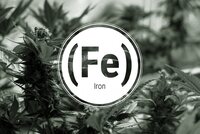- Thread starter
- #121
DrCannaCanadian
Well-Known Member
This is the cannabis E.R. and you might be reading this to save a marijuana crop. Time is of the essence. An Iron deficiency is an issue that can be easily missed, even by pro growers. Keep reading for the simple solution.
HOW TO IDENTIFY?
Accurate diagnosis is always step one when things start to go wrong in the cannabis garden. As soon as marijuana plants begin to display warning signs and look unhealthy, you must react fast. Unfortunately, iron deficiency is difficult to readily identify. That being said, we can tell you with confidence that yellow leaves will probably be the first indication a problem has already developed.
Iron deficiency is often misdiagnosed, routinely confused with calcium and magnesium deficiencies. Looking for yellow leaves is not enough; the grower must carefully inspect unhealthy cannabis plants. Literally from top to bottom. Precision is required to treat effectively.
Iron deficiency will be visible in the upper parts of the plant. Targeting the newest, freshest growth. In contrast, magnesium deficiency is often associated with leaves yellowing in the lower to middle portions of the plant.
The substrate that is most vulnerable is definitely coco coir. However, iron deficiencies can sometimes occur in hydroponic grows and rarely in soil too. Coco growers need to be on the lookout and remember not to confuse the yellow leaf symptoms for a Ca/Mg problem.
Overwatered roots in any medium, especially hydro setups, can lead to an iron deficiency. In fact, although iron deficiency is most obvious in new leaf growth, it really is a root zone issue. Cheap, low-grade soil with pH levels way above 6.0 can cause an iron deficiency and all kinds of additional nutrient lockout.
Moreover, iron is vital to enzyme function and chlorophyll production. Without it, plants will lose vigour and deteriorate. It may be a micronutrient, but it is absolutely essential to cannabis cultivation.
TREATMENT OPTIONS: FLUSH AND DIAL IT IN NEXT TIME
Flushing with pure 6.0pH water is a good start, regardless of the medium. Following this up in the next watering with a perfectly dialled-in (hydro-5.5pH and up to 6.5pH for soil) solution of nutes is usually just what the doctor ordered. If symptoms persist and you’re 100% certain pH is optimal, then add a specific micronutrient supplement with trace levels of iron to future feeds.
FLUSH AND UPGRADE NUTRIENTS
Again, a cleansing flush is the beginning of the treatment program. Too much fertiliser is often the cause of nutrient lockout. Flushing should remove nutrient salt build-up. Often, coco nutrient lines are lacking in iron and a deficiency is inevitable unless you upgrade to cannabis-specific nutrients.
Making the switch can be costly, but so is supplementing cheaper fertilisers and/or substrates. These are probably more expensive in the long run and really only provide a temporary patch. Upgrading nutrients is a permanent solution and the best way to prevent recurrence of iron deficiency.
An iron deficiency is often described as an immobile deficiency. In ordinary, decent grower terms, that means it doesn’t spread easily from the top down. Therefore, pruning affected growing tips is a viable option during vegetative growth. You could prune and pray, but we would rather you solve the iron deficiency. Prune to control height and encourage multiple tops while you thoroughly examine pH levels and nutrient doses to resolve the issue.
TIPS TO AVOID IRON DEFICIENCY
Investing in high-quality cultivation substrates and cannabis-specific nutrients is the way to avoid most of the common micronutrient deficiencies and grow headaches. Don’t expect primo buds without feeding marijuana plants every element required, in the right concentration, at the correct stage. Avoiding fluctuations in temperature and pH will help prevent shocks that also cause nutrient lockout. Iron deficiency is very treatable and entirely preventable.



























